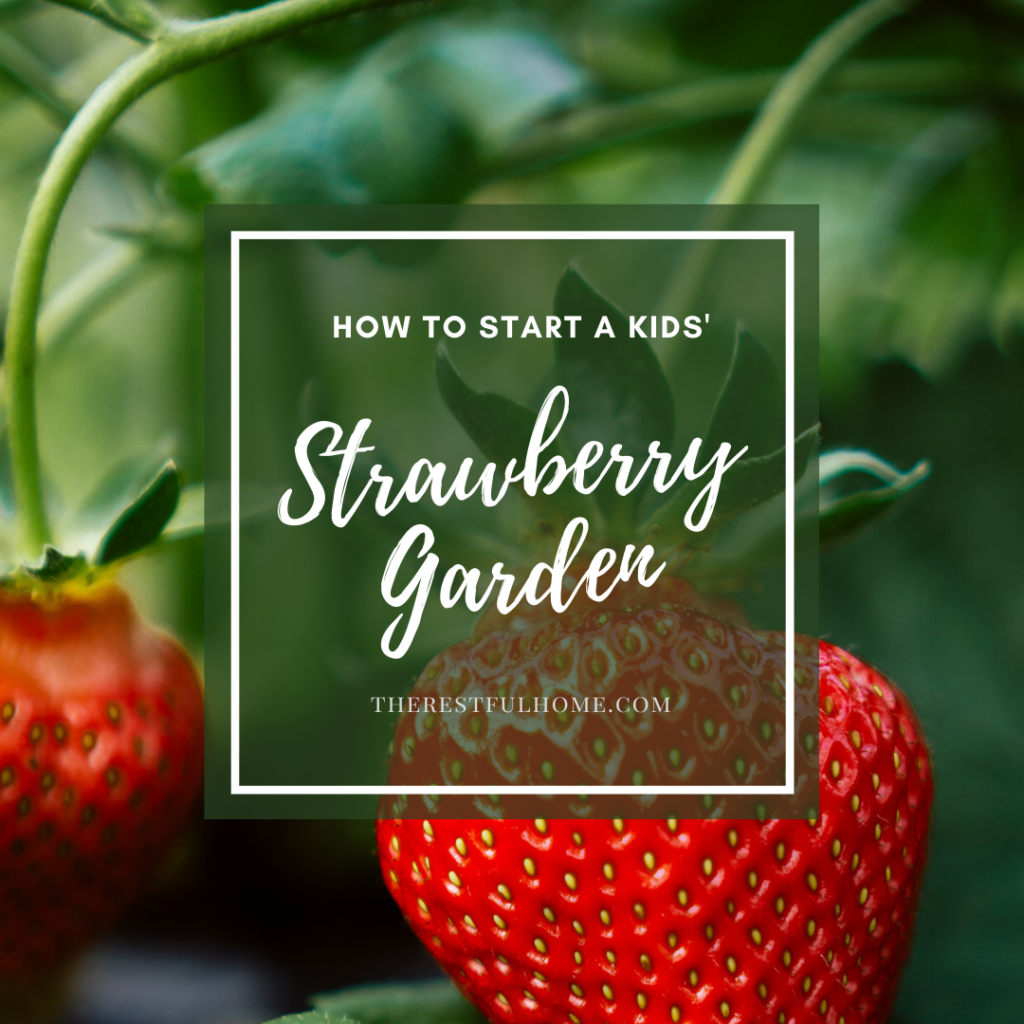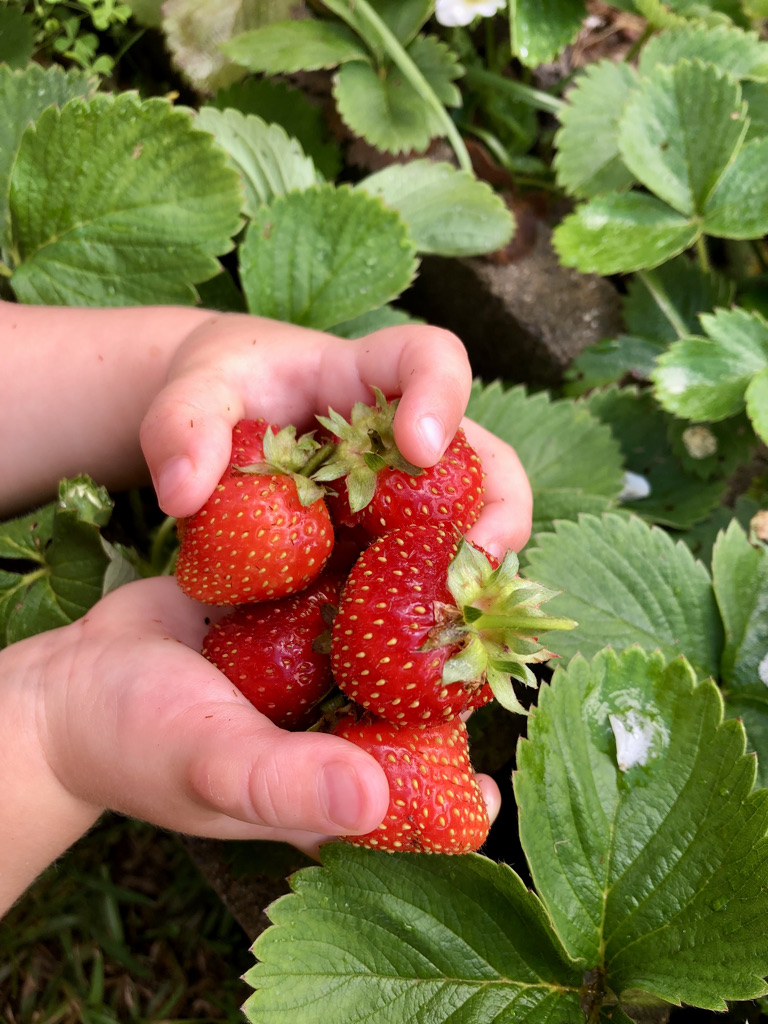
Fruit is almost everyone’s favorite thing to eat from the garden. Berries, especially, make eyes light up and little hands reach out for more. If you’re trying to interest your kids in growing food, starting a kids’ strawberry garden is the perfect way to begin the journey. Not only are you encouraging your kids to spend time outside, but you know exactly what’s on the food your kids are eating. (Strawberries almost always make the EWG’s lists of the dirtiest, most chemical-laden foods available at the grocery store.)

Getting Started on Your Strawberry Garden:
Choose a sunny area of your yard or balcony. Prepare the soil. Strawberries prefer good drainage, so if your soil is naturally dense clay, you’ll need to do some soil amendment. I added a little sand and a lot of compost to my strawberry bed. If you’re just planting in containers, just use standard potting soil.
How can you make the strawberry garden prep fun for the kids? By letting them help design the shape of the bed or pick out the pot you’ll use to plant the strawberries in. (The fabulous shape of strawberry jars allows strawberries to drop tendrils down into the cups along the side of the jar and start new plants in each cup!)
Older kids can help you figure out what kind of soil you have and what you need to do to it.
Planting
The least expensive way to start a strawberry garden is to buy bare roots. You can order them online from a nursery (choose one that’s in your area and sells varieties that will produce well where you live). You may also be able to find a nursery that sells them early enough in the season to get started at the right time. Where I live, in Texas, I needed to plant the bare root plants in February. I ordered in December from a nursery based a few hours away from us, and they delayed the shipment until the correct planting time for my zone.
When your bare root plants arrive, they look like pitiful, dead clumps of roots. But you’ll see as you separate the “plants” from each other that each one of them has a tiny crown. Show the kids how to keep the crown just above the soil when they plant the roots in the soil. Most gardeners recommend pinching off the blossoms of these baby plants during their first year, so the plants can get established.
If you just want an immediately finished strawberry garden, you can also buy mature plants. They will cost a lot more than the bare roots, but you’ll likely have a harvest in the first year.
Caring for the Strawberry Garden
Sometimes you might need to add nitrogen to your soil. If your strawberry plants have yellowing leaves instead of beautiful, deep green leaves, you may have this problem. Fish emulsion sprays or cottonseed meal are both organic sources of nitrogen that have worked really well for me in our strawberry garden.
Some varieties of strawberries also need to be thinned each year (half the plants or so will need to be dug up to leave room for new plants to grow). Strawberries spread naturally, so leave plenty of space for expansion. (You may have extra plants to share with friends!) Research your particular variety of strawberry to find out the needs of your strawberry garden.
Birds LOVE strawberries as much as we do. If they are eating more than their fair share, you can use some inexpensive netting to keep them away from the treasure. I got tired of birds eating only one peck out of a strawberry and then moving on to the next one, so I cover my strawberry garden each year just as the first fruit begins to form.
(Note: I wrap up the netting and reuse it each year so that we save money and don’t cause wildlife problems by discarding the netting, which could easily wrap around animals or birds.)
If you have trouble with slugs and snails eating all your strawberries, you can try slug traps: nestle a cup in the ground so the rim is soil-level. Then fill it halfway with beer or a yeasty water mixture. The slugs will smell the yeast and crawl into the cup.
Eating
This is the fun part! We have ever-bearing strawberries that produce most of their harvest in the spring but continue to give us fruit throughout much of the summer. My kids love searching for strawberries each time we go outside, and strawberry-hunting is also a favorite activity for their little friends who visit us.
If your strawberries start producing more than you can eat or give away, you can flash freeze them. Spread some out on a cookie sheet and freeze them in one layer for an hour or so. Then shake the mostly-frozen strawberries into a freezer bag. You can continue to add batches of flash-frozen strawberries to the bag until it is full, and you’ll be able to measure out exactly the amount you need.
What Have You Accomplished?
In the making of a strawberry garden you have:
-spent quality time with your kids outside
-provided a non-toxic, delicious snack for your family
-taught your kids how the food cycle works (from roots and stems to blossoms and fruit)
-overcome challenges (birds and slugs)
-enjoyed the unbeatable taste of a fresh strawberry spilling juice all over your tongue 🙂
What do you love most about gardening? What are you looking forward to doing with your kids or grandkids this year in the garden?
Let us know in the comments!
Coming soon:
I’m writing an eBook on gardening with kids. Subscribers will receive a free copy for a limited time when we first release it, so if you’re interested in growing food with your little ones (and keeping it fun!), drop your email in the newsletter form!
